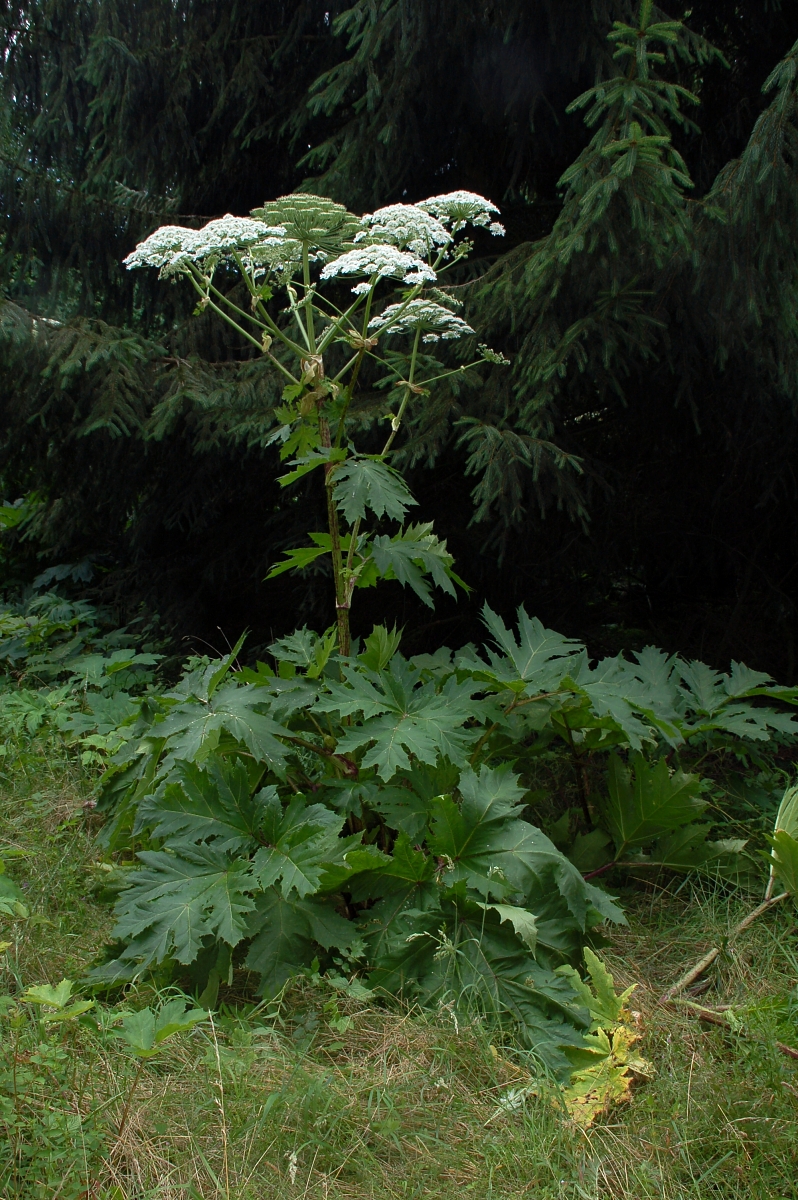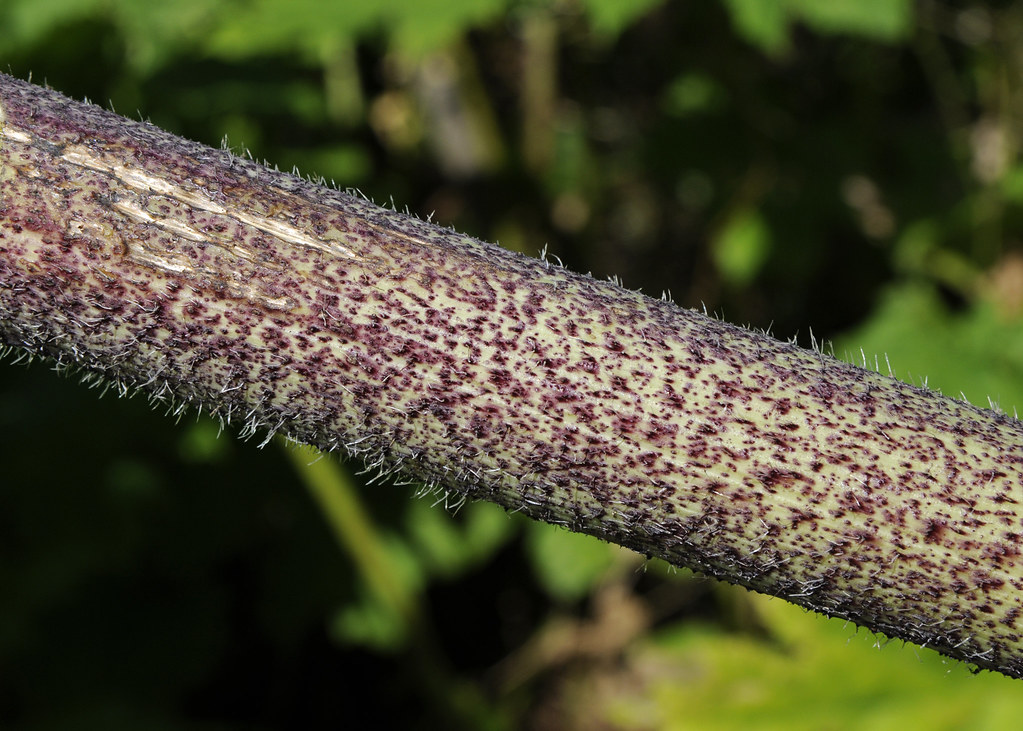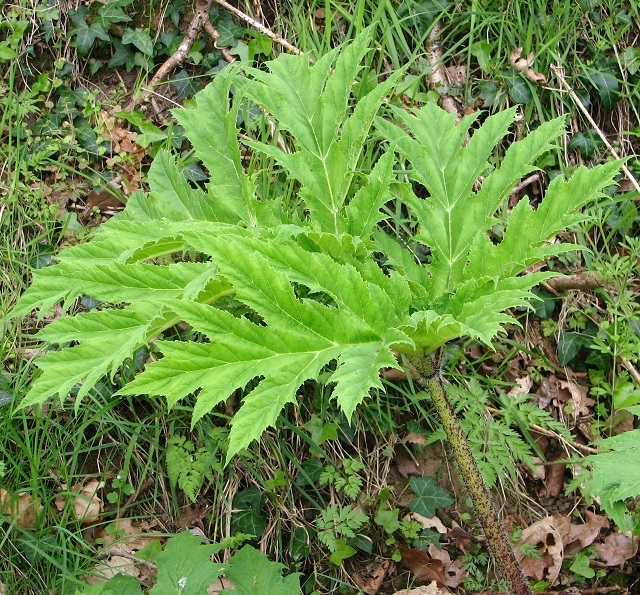Giant Hogweed

Giant Hogweed
(Heracleum mantegazzianum)
Priority: - Eradicate
Tags: Terrestrial | Toxic
Identification and Reproduction
- Large upright plant up to 5 meters in height growing from a single hollow stem.
- Stem is ridged, with evident reddish-purple spots and stiff white hairs.
- Leaves are dark green, toothed, and deeply cut into three large segments with stiff hairs on the undersides
- Clustered white flowers in large umbrella-shaped heads up to 0.8 m in diameter
- Biennial that produces thousands of winged seeds.
Look-alikes
We have guides to help you differentiate Giant Hogweed from the native plant Cow Parsnip (Go to Hogweed Guide), or other invasive plants in the carrot family (See the guide here)
Habitat & Ecology
Prefers damp, rich soils but can tolerate nutrient-poor sites. Found in riparian areas and along roadsides, ditches, and disturbed sites.
Impacts
Social:
HIGHLY TOXIC - DO NOT TOUCH, WASH SKIN IMMEDIATELY IF YOU COME INTO CONTACT WITH SAP
- Very large plant with large flowers. Poses a health and safety risk as it contains toxic sap that can cause burns, blisters, and scarring of the skin. This plants leaves, stems, flowers as well as roots will contain the toxic sap.
- If exposed to sap, avoid touching eyes, wash skin with soap, and cover from the sunlight for a minimum of 48 hours after contact.
Ecological:
- This vigorous plant often out-competes native species and will rapidly invade ravines and streambanks.
- Giant hogweed also has shallow roots which increases erosion in streambanks.
Management
Use protective clothing and eyewear when handling this plant. Personal protective equipment includes, googles, long pants and long-sleeved shirt, rubber globes and rubber boots. This is intended to minimize skin exposure.
Mechanical/Manual Control:
- If possible, avoid removal during summer as they are very tall and sappy at this time of year.
- Cut off flowers to prevent seed production. It is advised to remove flower head around May and June.
- Excavate plants, digging up root systems.
- Refrain from using power equipment to remove giant hogweed as this can splash toxic sap and spread seeds further.
- Taproots can be cut for small infestations. It is suggested to use loopers and cut the plant down about 15 cm below the ground surface. Severing the taproot should occur during early spring (April and May).
- Immature plants can be controlled by covering with black plastic or by mowing at 2 week intervals; 3-5 years of follow-up treatment may be required.
- Do not compost - dispose of all plant parts in strong garbage bags.
- Plant material can be left on-site to decompose unless site is highly accessible to people.
Chemical Control:
- Foliar applications are most effective during the spring.
- Stem injection is best used in an infestation where other vegetation is dispersed throughout.
- Glyphosate and triclopyr have shown success.
- Please carefully read herbicide labels prior to application.
For further details on proper giant hogweed chemical control please refer to the Metro Vancouver's BMP for giant hogweed (pg. 11-20).
Resources
Watch the Attack of the Giant Hogweed:
Download WorkSafe BC's Toxic Plant Warning on Giant Hogweed here.
Download the Invasive Species Council of BC's Giant Hogweed TIPS brochure here.
Download the Metro Vancouver's Best Management Practices for Giant Hogweed here.
Download the Invasive Species Centre Best Management Practice Technical Document for Land Managers here.
For more help properly identifying and comparing Giant Hogweed to look-a-like species be sure to check out Maine's Department of Agriculture, Conservation and Forestry's resource guide here.
Download the Metro Vancouver Factsheet on Giant Hogweed here.
Header photo (Jean-Pol GRANDMONT).
Photo Gallery






















